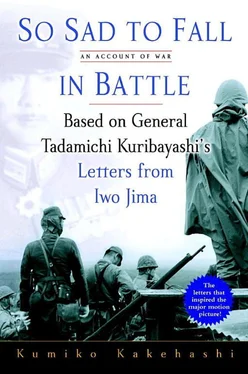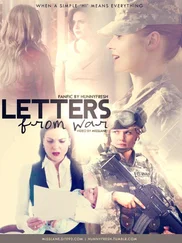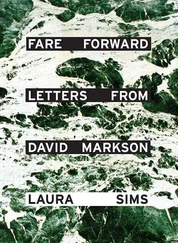They made a whistling sound as they fell. Then the earth shook. There were explosions. Rocks, earth, and sand all flew up into the air. Then they fell back down. They made craters ten meters wide and five meters deep in the earth.
No one could survive in these conditions. Any Japanese soldiers, like the runners who went outside, were all killed. The only option was to take advantage of the night and go out then.
With the advent of night, the Japanese came up to the surface and repaired their defenses. When the American ships fired off flares, they would again take refuge in their underground shelters, only to crawl out when darkness returned.
After three days in which the Japanese had endured a bombardment fierce enough to shake the whole island, the day finally arrived: D-day, the day the invasion started.
3:00 a.m., February 19: The beating of the wake-up gong rouses the marines. Breakfast is steak and eggs, the traditional D-Day menu.
6:30 a.m.: The order is given for the landing force to land. The first of the landing craft is lowered into the sea.
6:40 a.m.: The final prelanding naval bombardment begins. Eight battleships, nineteen cruisers, and forty-four destroyers start firing their guns at the same time.
8:05 a.m.: Fighter planes take off from the carriers. A total of seventy-two planes take part in the attack; the navy fighters are Corsairs and Hellcats, the bombers are Dauntless dive bombers. Once they’re back, the forty-eight planes of the marine squadron go up into the air for their turn.
8:25 a.m.: The naval barrage resumes. The scale of this day’s naval bombardment surpasses the Normandy landings to become the biggest in the whole of World War II.
Such was the unbridled ferocity of the bombardment that clouds of dust and debris shot up eight meters in the air. In Iwo Jima: Legacy of Valor , Bill D. Ross, a former marine sergeant combat correspondent attached to the Third Marine Division, described the reactions of the marines who were looking at the island from the sea.
Men on the jammed decks of transports, others in Higgins boats or in amtracs disgorged from LSTs, watched and wondered how any Japanese could survive.
In a similar vein, James Bradley, who interviewed many marine veterans for his book, has the following episode in Flags of Our Fathers:
In these final moments, eighteen-year-old Jim Buchanan of Portland, Oregon, could still view the bombing as a beautiful tableau, like in a movie; the island nearly invisible beneath clouds of gray, yellow, and white dust from all the rockets and bombs. He turned to his buddy, a kid named Scotty, and asked hopefully: “Do you think there will be any Japanese left for us?”
Was it possible that there were any living, breathing people left on the island, which now looked like a burned steak? The marines had a sense that maybe, just maybe, the landing would go off more easily than they expected.
They could not have been more wrong.
H HOUR (THE TIME FOR THE ACTUAL LANDING) was set for 9:00 a.m. on the dot. At 9:02, two minutes behind schedule, the first landing craft hit the beach.
As Kuribayashi had predicted, the landing point was the beach on the south coast of the island. The Japanese allowed the landing operation to go ahead without offering the slightest resistance. Only after 10 a.m., when the beach was jam-packed with marines, supplies, and munitions, did they start their attack. Shells and gunfire rained down onto the beach, while antiaircraft guns and artillery, their barrels lowered, began to pick off the landing craft.
It was funshinhô —rocket guns—that wreaked the greatest havoc. They fired self-propelled shells, and unlike large pieces of artillery, they did not need large launching frames so they could be transported and assembled with ease. The Japanese had been using rocket guns in combat in the South Seas since 1943. They were among the most deadly and effective weapons that Kuribayashi was given by the military central command, and they were a major factor in the robust resistance of the Iwo Jima garrison.
The black sand on the southern beaches was soft volcanic cinders, and the ground was broken into a series of terraces. The marines who had come ashore sank in up to their ankles with every step they took, and with their feet bogging down in sand with the texture of coffee beans, getting beyond the terraces proved difficult. The beach looked like rush hour with all the marines milling about.
Artillery fire came cascading down on them relentlessly. The beach offered no cover and digging trenches was impossible. The Americans could move neither forward nor back, and the casualties mounted. Such was the power of the rocket guns that a direct hit would literally blow someone to bits. The gruesome carnage struck terror into the Americans, and for a short time the beach was a scene of panic and chaos.
Kuribayashi’s strategy—allowing the Americans to land before picking them off from close quarters rather than clinging to the old orthodoxy of stopping the enemy from coming ashore—proved itself effective. On that single day, 566 American soldiers were killed or missing in action; 1,755 were wounded; and 99 were so traumatized that they could fight no more. This adds up to 8 percent of the total 31,000-man-strong landing force.
The Japanese side sustained heavy damage, too. The defenses at the water’s edge were put almost completely out of action on the first day (though their loss was already factored in). Kuribayashi never planned on a showdown at the water’s edge; his aim was to inflict as much damage as he could, then continue to resist from his main inland defenses, before finally holing up in the honeycomb position.
The sun set on D-Day at 6:45 p.m., but night did not mean sleep for the exhausted marines: they had no way of knowing when the banzai charge might come.
The Americans were sure there would be a large-scale banzai charge on the day they landed. It had been that way on every other Pacific island they had invaded up to this point. Officers brandishing Japanese swords, soldiers armed with bayonets and grenades, the sound of strange voices, howls, cry after cry of “banzai.” Although the Americans hated and feared these attacks, they also represented an opportunity to dramatically reduce the fighting power of the Japanese. The Japanese soldiers who charged in so recklessly were always equally quickly slaughtered.
The combination of casualties from the fighting on the beach by day and the banzai charge at night usually meant that the fighting ability of the Japanese would fall sharply on the first day of any battle. That was the basis of the Americans’ conviction that Iwo Jima would fall in five days.
Early morning on D-day plus one (the day after the landing), Lieutenant General Smith was on the deck of the Eldorado , gazing at the island and wondering why the Japanese had not yet made their banzai charge. Smith did not yet know what kind of man the commander in chief of Iwo Jima was.
Kuribayashi’s battle was only just getting started.
WHAT WAS KURIBAYASHI THINKING in the battle command post in the Command Center when the Americans came ashore?
Accounts written by American historians tend to paint a picture of Kuribayashi, the consummate samurai warrior, biding his time, ready to pounce on the enemy. But what was really passing through his mind?
“America is the last country in the world Japan should fight.”
This was something Kuribayashi had told his family repeatedly before the outbreak of war. His opinion derived from the time he had spent in the United States and the evidence of the power of the country he had seen with his own eyes. “It was because His Lordship the General was opposed to starting a war against the United States that Prime Minister Tôjô disliked him and ordered him off to Iwo Jima.” This is still the opinion of Sadaoka Nobuyoshi, the former army civilian employee.
Читать дальше












